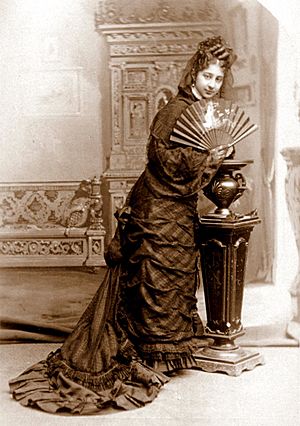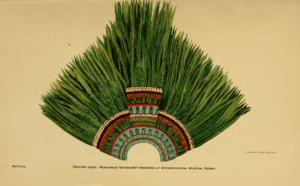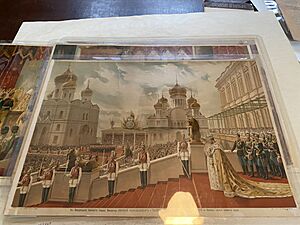Zelia Nuttall facts for kids
Quick facts for kids
Zelia Nuttall
|
|
|---|---|

Zelia Nuttall
|
|
| Born |
Zelia Maria Magdalena Nuttall
September 6, 1857 |
| Died | April 12, 1933 (aged 75) Casa de Alvarado, Coyoacán, Mexico
|
| Nationality | American |
| Occupation | archaeologist |
| Known for | Mexican archaeology |
| Spouse(s) |
Alphonse Pinart
(m. 1880; div. 1888) |
| Children | Nadine Nuttall Laughton (née Pinart) |
| Parent(s) | Robert Kennedy Nuttall Magdalena Parrott |
| Relatives | George Nuttall (brother) |
Zelia Maria Magdalena Nuttall (born September 6, 1857 – died April 12, 1933) was an American archaeologist and anthropologist. She was an expert in ancient Mexican cultures, especially those before the Aztecs. Zelia also studied old manuscripts from this time.
She found two important forgotten manuscripts. One of them is now called the Codex Zouche-Nuttall. Zelia was one of the first people to recognize and study artifacts from the time before the Aztec empire.
Contents
Zelia Nuttall's Early Life
Zelia Nuttall was born in San Francisco, California, on September 6, 1857. She was one of six children. Her father, Robert Kennedy Nuttall, was a doctor from Ireland. Her mother, Magdalena Parrott, was Mexican-American. Zelia's grandfather was a very rich banker in San Francisco.
When Zelia was eight, her family moved to Europe. She went to school in France, Germany, Italy, and London. Zelia became very good at languages. She could speak four languages fluently and knew a bit of others.
Marriage and First Steps in Archaeology
In 1879, Zelia's family came back to San Francisco. There, she met Alphonse Pinart, a French ethnologist. He was in the city for a research trip. They got married in 1880. Zelia traveled with Alphonse as he did research in the West Indies, France, and Spain.
They separated a year later, just before their daughter was born. They officially divorced in 1888. Zelia and her daughter went back to using Zelia's maiden name, Nuttall.
In 1884, Zelia visited Mexico for the first time. She stayed for five months with her mother's family. During this trip, she became very interested in Mexican history and archaeology.
In 1886, she wrote her first professional article. It was about "Terra Cotta Heads of Teotihuacan." Zelia showed that these figures were much older than people thought. She also explained they were used in burial ceremonies. Experts liked her paper a lot. She became a member of important groups like the Archaeological Institute of America. The Peabody Museum of Archaeology and Ethnology at Harvard University made her a special assistant. She held this honorary job for 47 years.
Discovering Ancient Manuscripts
In 1886, Zelia moved to Dresden, Germany. For the next 12 years, she searched libraries and museums across Europe. She was looking for information about Mexico's history.
One of her biggest finds was an ancient document with Mixtec pictographs. This document is now called the Codex Nuttall. She found it in a private library in England. Zelia couldn't buy the codex, but she hired an artist to make a careful copy. The Peabody Museum published this copy in 1902.
Another important discovery was the Codex Magliabechiano. She published this in 1903. Her book was called The Book of the Life of the Ancient Mexicans. It included her own introduction, translation, and notes.
New Ideas and Important Friends
In 1901, Zelia published her biggest academic book. It was called The Fundamental Principles of New and Old World Civilizations. Some of her ideas in this book were later found to be incorrect. For example, she thought that ancient Phoenicians sailed to the Americas. She believed this influenced Mesoamerican cultures to develop like those in Egypt. Today, archaeologists do not agree with this idea.
During a trip back to California, Zelia met a rich helper named Phoebe Hearst. Phoebe became Zelia's friend and supported her work. Phoebe helped Zelia join a trip to Russia to collect old cultural items for a museum. In 1901, Phoebe also helped start an anthropology department and museum at the University of California, Berkeley. She invited Zelia to help organize it.
Life in Mexico
In 1902, Zelia returned to Mexico. She worked with the new anthropology department at Berkeley. Phoebe Hearst gave money for Zelia to buy a large Spanish colonial house near Mexico City. Zelia renamed her home Casa de Alvarado. It became her main place for archaeology work. It was also a meeting spot for scientists and thinkers.
Zelia loved gardening at Casa Alvarado. She studied Mexican garden art and grew medicinal herbs. She also collected seeds of ancient Mexican food plants. She wanted to introduce them to the United States.
In 1908, Zelia found an unknown manuscript in the National Archives of Mexico. It was about Francis Drake's voyage around the world. This discovery made her search for more documents about Drake and John Hawkins. She looked in archives in New York, Spain, Italy, and France. She found more than 65 documents that had never been published. She translated them for her book, New Light on Drake, published in 1914.
Supporting Mexican Culture
Zelia Nuttall worked to help people appreciate Mexico's past. She wanted to give pride to its present. In 1897, she wrote an article called Ancient Mexican Superstitions. In it, she said that people often saw ancient Mexicans as "bloodthirsty savages." She wanted to change this idea. She hoped her work would show how people today are connected to their amazing ancestors.
Zelia also worked with Phoebe Hearst to help educate and protect the heritage of native Mexicans. One of her students, Manuel Gamio, later became a very famous archaeologist in Mexico.
Zelia wanted to bring back Mexican traditions that were lost after the Spanish conquest. In 1928, she asked for a renewed celebration of the native New Year. Many ancient Mexican cultures used to celebrate it twice a year. That year, Mexico City celebrated the Aztec New Year for the first time since 1519.
Trip to Russia
In 1894, Zelia Nuttall went to Russia. She was representing the Penn Museum. Her goal was to set up exchanges with Russian museums. She also offered money for Russian archaeological digs. In return, the Penn Museum would get some of the discoveries.
Zelia was chosen because she knew Russian. She also had the chance to attend the coronation of Nicholas II and Alexandra Feodorovna. This happened because Phoebe Hearst canceled her trip and gave the opportunity to the Penn Museum.
While in Moscow, Zelia arranged several exchanges between Russian museums and the Penn Museum. She also visited a big exhibition in Nizhny Novgorod. There, she looked at many artifacts from places as far away as Siberia. She collected over 400 items from Russia, Finland, and Poland. These items included religious objects, musical instruments, and pottery. She also got a collection of photos showing the customs of the Kyrgyz people.
Zelia Nuttall passed away on April 12, 1933, at her home in Mexico. She was a member of several important academic groups. She did most of her work without pay. In 1895, she became a member of the American Philosophical Society.
See also
 In Spanish: Zelia Nuttall para niños
In Spanish: Zelia Nuttall para niños



